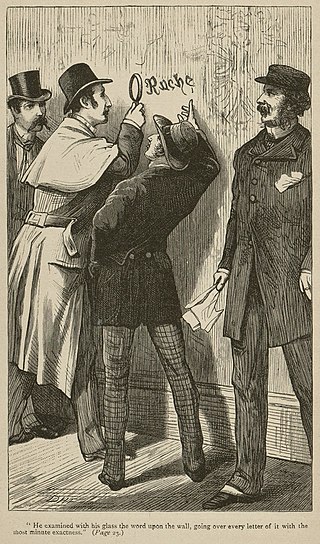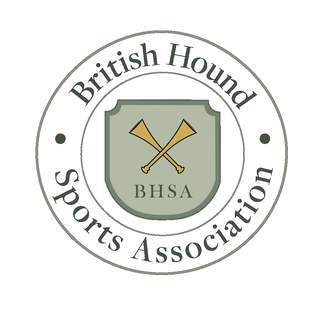
Hound trailing, or hound racing, is a dog sport that uses specially bred hounds to race along an artificially laid scent trail over a cross country course.

Hound trailing, or hound racing, is a dog sport that uses specially bred hounds to race along an artificially laid scent trail over a cross country course.
Hound trailing is a race between hounds along an artificially laid scent trail. The sport is a combination of drag hunting, dog racing and steeplechasing, with the hounds taking the place of horses. [1] The hounds follow a man-laid scent, the scent trail being usually laid by dragging a piece of fabric, slightly soaked with a combination of aniseed and paraffin oil, along the course. [1] [2]
Trail hounds over 2 years old race in adult races, whilst those between 1 year old and 2 years old race in puppy races. Adult races are approximately 10 miles (16 km) long and the hounds in the adult races typically take 30 minutes to finish; times outside 25 and 45 minutes are declared void. Puppy races are approximately 5 miles (8.0 km) long. When racing, the hounds' coats are closely shaved to prevent them from overheating during the race. [2] [3] [4]
Unlike in other forms of hunting, humans do not follow the hounds, instead the hounds conduct the course unassisted and spectators can observe parts of the race from vantage points through binoculars. The season is between April and October and the hound that wins the most races in a season is crowned the season's champion. [1] [2] [3] [5]
Hound trailing is effectively confined to the British Isles, it is particularly popular in Cumbria, the Scottish Borders, parts of Yorkshire and parts of Ireland. [2] [3]
Hound trailing originated in the 18th century as a means of various hunt masters testing their fox hounds against each other in match races. [6]
In 1763 a celebrated match race for 500 guineas occurred between John Smith-Barry's prized Bluecap and Bluecap's daughter Wanton against Hugo Meynell's Richmond and a favourite bitch from the Quorn Hunt. A 4-mile (6.4 km) drag was laid at Newmarket Heath with Bluecap winning in a little over 8 minutes, Wanton a close second, Richmond third by over 100 yards (91 m) and the bitch failing to finish. Of the 60 horses that started with the hounds, only 12 finished. As a comparison, it was said that Eclipse ran a 4-mile race at York, carrying 12-stone (76 kg), in the same time. [6] [7] [8]
Another early example was that of Colonel Thomas Thornton's bitch Merkin, with whom in the 1790s Colonel Thornton challenged any hound in England of the same age to beat over a 5-mile (8.0 km) course, for 10,000 guineas and giving 220 yards (200 m). Merkin had run a 4-mile trail at Newmarket in 7 minutes and half a second. Later Colonel Thornton challenged any hound in England to a match with his 2-year-old hound Madcap for 500 guineas and giving 100 yards. Madcap's brother Lounger, at 4 years old, was challenged to a match against Hugo Meynell's Pillager and any other hound of Meynell's choosing, although upon sighting Lounger it was felt best by Meynell to forfeit. [6] [7] [9]
Hound trailing or hound racing became particularly popular in the Lake District, with hunt masters of packs conducting match races over laid drag lines. The rapid rise in the popularity of the sport led to the establishment of the Hound Trailing Association in 1906, this was followed by the Border Hound Trailing Association in 1933 and later the Yorkshire Hound Trailing Association and associations in County Cork and County Kerry. [1] [6] [10]

Trail hounds have evolved into a distinct breed or type of hound specifically bred for performance alone, they are sleek, hard muscled hounds with almost whippet like bodies. [2] [6]
Trail hounds descend from the Fell hounds, foxhounds found in the north of England. In his Foxes, foxhounds and fox-hunting, Richard Clapham stated "fell hounds trace their origin back to the old Talbot tans, while they later acquired a certain infusion of pointer blood ... in order to make hounds carry their heads higher." He further states the "fell hound is the antithesis of the Peterborough type. Instead of size, weight and power, we have lightness, activity, and pace, coupled with wonderful stamina..." In his Hounds of the World, Sir John Buchanan-Jardine stated the fell hound was descended from the Chien Blanc, a French hound that shares a common ancestor with the Poitevin, a scent hound known for its speed. [6] [11] [12]
Later harrier blood was introduced. In 1919 a Windemere Harrier Cracker was introduced, in 1922 further harrier blood was introduced from Lancashire packs and in 1928 a harrier Beware sired a litter that was to become dominant in hound trailing. Further out-crosses introduced pointer blood, in the mid-1920s a pointer-harrier cross bitch Gravity was introduced, whose descendants remain influential to this day. [6]
Famous trail hounds include Rattler, the first hound to win a hundred prizes but was poisoned by a competitor and Hartsop Magic who won thirty two prizes in 1985, twenty six in 1986 and thirty three in 1987. And more recently Progress, Progress was in the Border Hound Trailing Association, in his racing career he won 4 Senior championships, 3 Langholm common ridings and A international.also in the four Seasons he ran 280 Trails, finishing in the first 6 233 times, 202 of those times in the first 3. [6]

The Harrier is a medium-sized dog breed of the hound class, used for hunting hares by trailing them. It resembles an English Foxhound but is slightly smaller, though not as small as a Beagle. The breed has been used since the mid 13th century.

Fox hunting is a traditional activity involving the tracking, chase and, if caught, the killing of a fox, normally a red fox, by trained foxhounds or other scent hounds. A group of unarmed followers, led by a "master of foxhounds", follow the hounds on foot or on horseback.

Scent hounds are a type of hound that primarily hunts by scent rather than sight. These breeds are hunting dogs and are generally regarded as having some of the most sensitive noses among dogs. Scent hounds specialize in following scent or smells. Most of them tend to have long, drooping ears and large nasal cavities to enhance smell sensitivity. They need to have relatively high endurance to be able to keep track of scent over long distances and rough terrain. It is believed that they were first bred by the Celts by crossbreeding mastiff-type dogs with sighthounds. The first established scent hounds were St. Hubert Hounds bred by monks in Belgium during the Middle Ages.

Beagling is mainly the hunting of hares and rabbits by beagles using their strong sense of smell. A beagle pack is usually followed on foot, but in a few cases mounted. Beagling is often enjoyed by 'retired' fox hunters who have either sustained too many injuries or lost the agility to ride horseback, or who enjoy the outdoors and the camaraderie of the hunt. It is also traditionally a way for young men and women to learn how to handle hounds on a smaller scale before they go on to hunt with foxhounds.

The Pointer, sometimes called the English Pointer, is a medium-sized breed of pointing dog developed in England. Pointers are used to find game for hunters, and are considered by gundog enthusiasts to be one of the finest breeds of its type; however, unlike most other hunting breeds, its purpose is to point, not retrieve game.

Drag hunting or draghunting is a form of equestrian sport, where mounted riders hunt the trail of an artificially laid scent with hounds.

The American Foxhound is a breed of dog, closely related to the English Foxhound. They are scent hounds, bred to hunt foxes by scent. United States Founding Father George Washington was key to the breed's early development.

A red herring is something that misleads or distracts from a relevant or important question. It may be either a logical fallacy or a literary device that leads readers or audiences toward a false conclusion. A red herring may be used intentionally, as in mystery fiction or as part of rhetorical strategies, or may be used in argumentation inadvertently.
A paper chase is an outdoor racing game with any number of players.

The Southern Hound was a breed of dog that existed in Britain probably until sometime in the 19th century, now extinct. The exact date of its extinction is not known; it is likely that it was gradually interbred with other breeds until the genuine Southern Hound bloodline ceased to exist.

The bloodhound is a large scent hound, originally bred for hunting deer, wild boar, rabbits, and since the Middle Ages, for tracking people. Believed to be descended from hounds once kept at the Abbey of Saint-Hubert, Belgium, in French it is called, le chien de Saint-Hubert.

The Quorn Hunt, usually called the Quorn, established in 1696, is one of the world's oldest fox hunting packs and claims to be the United Kingdom's most famous hunt. Its country is mostly in Leicestershire, together with some smaller areas of Nottinghamshire and Derbyshire.

Trail hunting is a legal, although controversial, alternative to hunting animals with hounds in Great Britain. A trail of animal urine is laid in advance of the 'hunt', and then tracked by the hound pack and a group of followers; on foot, horseback, or both.
Mink hunting is a country sport involving the hunting of American mink with scent hounds along the waterways which make up their habitat, in a manner similar to fox hunting. Mink hunting took place in the countryside in the UK and Ireland, but since 2005 traditional mink hunting has been banned in England and Wales.
The Bluecap Memorial stands in the yard of the Cheshire Hunt Kennels in Kennel Lane, Sandiway, Cheshire, England. Bluecap was a Cheshire foxhound that was famous for winning a race against the hounds of Hugo Meynell of the Quorn Hunt in 1763. The memorial is in sandstone and consists of an obelisk standing on a plinth, with a brass plaque inscribed with a poem. It is recorded in the National Heritage List for England as a designated Grade II listed building.

The Warwickshire Hunt is an English fox hunting pack founded in 1791.

The Staghound, sometimes referred to as the English Staghound, is an extinct breed of scent hound from England. A pack hound, the breed was used to hunt red deer and became extinct in the 19th century when the last pack was sold.

The West Country Harrier, sometimes called Somerset Harrier, is a breed of scent hound from the south west of England that is used to hunt hare in packs. The West Country Harrier is often considered to be a variety of the more common Harrier breed, which is sometimes referred to as the Studbook Harrier.

The British Hound Sports Association (BHSA) is the governing body for many hound sports associations in Great Britain. However, it is not the governing body for either draghound packs or bloodhound packs who are governed by the Master of Draghound & Bloodhounds Association (MDBA). The BHSA is responsible for setting standards and rules to which members and registered hunts are supposed to adhere. A sister organisation, the Hound Sports Regulatory Authority (HSRA), is responsible for regulatory and disciplinary matters for members and member hunts, in accordance with rules set by the BHSA.